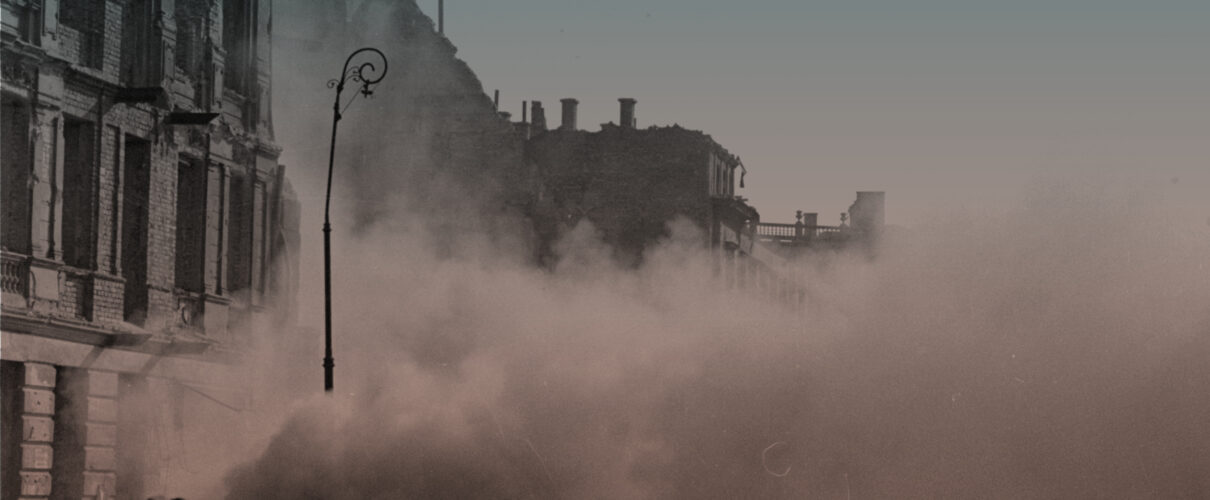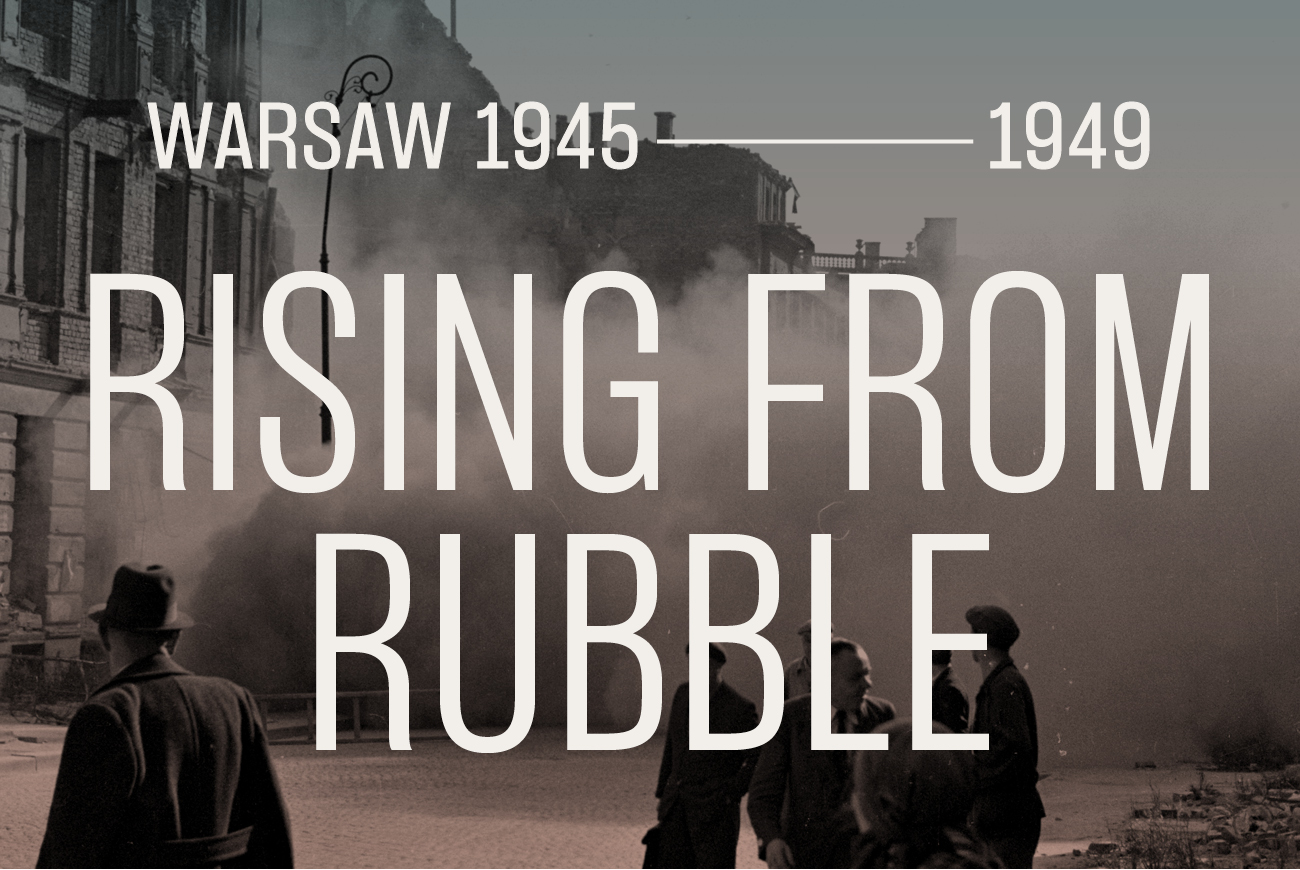EXHIBITIONS

30 March - 3 September 2023
20PLN regular/15PLN concessions, free admission on Thursdays
Warsaw 1945-1949: Rising from Rubble

Опис виставки нижче.
How was the city of Warsaw reconstructed?
Warsaw has risen from rubble. Indeed—rubble was the basic building material, and working amidst the ruins was the stuff of life. Reconstruction was a complex process which required a huge amount of time and labour. It affected Warsaw’s architecture as well as its cityscape. It also had an effect on the social and economic relations that were being rebuilt anew after the war.
Warsaw 1945-1949: Rising from Rubble exhibition offers a new perspective on the myth of the postwar reconstruction of the Polish capital city and one of the most interesting pages in its history.
THE RECONSTRUCTION PHENOMENON
The exhibition presents a unique character of the city being rebuilt thanks to a collective effort. It follows the process of transforming ruins into rubble, and rubble into building material from which the Varsovians constructed their own future and the future of their city. The first years after the war were spent on removing the rubble and pulling down the ruins. Bricks and iron were being recovered and breeze-blocks were produced of concrete and rubble.
It is the first time that rubble constitutes the narrative core of an exhibition devoted to the reconstruction of Warsaw. We show fragments of sculptures and architecture, stove tiles and ceramics as well as materials used in the process of reconstruction: demolition bricks and rubble concrete. Photographs, graphic art, paintings, documents, maps, iconography as well as film newsreels and oral history video recordings place these exhibits in their historical context. Contemporary context is provided by the works by artists such as Diana Lelonek or Monika Sosnowska, produced especially for this exhibition.
22 MILLION CUBIC METRES OF RUBBLE
What happened to ca 22 million cubic metres of rubble which covered almost the entire city after the war?
- Widok wystawy Zgruzowstanie Warszawy 1945-1949 w Muzeum Warszawy, fot. T. Kaczor
- Widok wystawy Zgruzowstanie Warszawy 1945-1949 w Muzeum Warszawy, fot. T. Kaczor
- Widok wystawy Zgruzowstanie Warszawy 1945-1949 w Muzeum Warszawy, fot. T. Kaczor
The exhibition provides an answer to this question as well. In the first years of the reconstruction, the status of rubble was evolving. Initially, it was considered a waste material which ought to be removed. Next, it was regarded as a raw material to be recovered and used to produce new building materials. Ultimately, rubble acquired the status of a symbol of hard collective labour and a bright future for Warsaw and the entire country. This symbol, so eagerly used by the communist regime, is now given a chance to be interpreted anew.
OVER 500 ARTEFACTS IN SEVEN ROOMS
The exhibition narrative leads us through the first four years of Warsaw reconstruction. Artistic images of the ruins reflect the experiences of the people who returned to the war-torn capital first. Artists produced paintings, drawings and photographs. As we proceed to the next room, the ruins come to life, people lead their daily existence and first demolitions begin. A large part of the cleaning-up was carried out by women from the Labour Brigades.
Bricks grow to be invaluable. They are transported to Warsaw from Wrocław, Szczecin and other cities and towns of western Poland in its new postwar borders. Concrete rubble is invented and first attempts are soon made at putting it into use. Breeze blocks made of concrete and rubble were used while constructing the Koło II housing estate, or the edifice of today’s Ministry of Development and Technology at Trzech Krzyży Square.
The exhibition closes with a broader perspective on Warsaw’s cityscape which had undergone a major transformation, evident in the street grid and building development. The Warsaw Rising Mound as well as Moczydłowska or Szczęśliwicka Hills—all made of rubble—are now an organic part of the city, and yet their development still sparks off debates.
- Widok wystawy Zgruzowstanie Warszawy 1945-1949 w Muzeum Warszawy, fot. T. Kaczor
- Widok wystawy Zgruzowstanie Warszawy 1945-1949 w Muzeum Warszawy, fot. T. Kaczor
Aside from the original rubble and materials used during the city reconstruction, the exhibition also boasts works by artists such as Zofia Chomętowska, Jan Bułhak, Alfred Funkiewicz, Wojciech Fangor, Antoni Suchanek, as well as contemporary artists: Monika Sosnowska, Tymek Borowski or Diana Lelonek. They are complemented by archival documents, maps, fragments of film newsreels and memoirs.
TOURING WITH A CHILD
Cards with tasks. Interesting stories are hidden in-between rubble. The riddles we have prepared for you will help you discover them.
How does it work? Having purchased the tickets, approach a member of staff in the exhibition hall and collect a card with tasks and crayons.
Solve the riddles while touring the exhibition and, above all else, have a great time!
For whom: families with children aged 6–12
Price: ticket for the temporary exhibition
When: anytime during the Museum of Warsaw opening hours
Location: ticket desk in the tenement house at no. 32
Як виглядала відбудова столиці?
Варшава постала з руїн. Будівельне сміття було основним матеріалом для будівництва, а робота на руїнах була звичною справою. Відбудова потребувала величезних накладів праці та часу. Вона вплинула на архітектуру міста, його ландшафт, пожвавлення соціально-економічних відносин. Виставка «Варшава, що поставала з руїн 1945-1949» – це новий погляд на міф про столицю, що відроджувалася після війни, і один із найцікавіших розділів її історії.
21 травня (неділя), 16:00
Екскурсія українською мовою з Петром Владіміровим.
COLOPHON
Curator: Adam Przywara
Historian and scholar of architecture. In 2022, he obtained PhD from the University of Manchester for a dissertation devoted to the historical investigation of the materiality of ruins in the postwar reconstruction of Warsaw. Currently he is associated with the Université de Fribourg. Adam was a fellow at the Bauhaus Foundation in Dessau (2018) and at the Deutsches Historisches Institut Warschau (2020). He curated the exhibition titled See You After the Revolution! at the Arsenal Gallery in Białystok (2019). His research interests focus on the changes in the materiality of the 20th-century architecture, as well as the circular economy in both contemporary and historic construction.
Cooperation: Katarzyna Jolanta Górska
Exhibition design: Studio Okuljar Architekt*innen SIA
Production: Marta Galewska, Katarzyna Jolanta Górska
Exhibition graphic design: Alina Rybacka-Gruszczyńska
Poster and promotional materials graphic design: Anna Światłowska, based on Alfred Funkiewicz’s photo titled Demolition of buildings on Wilcza Street, 1946, Museum of Warsaw
Maps: Karolina Pietrzyk
Photos: Diana Lelonek, Antonina Gugała
Editing and proofreading: Urszula Drabińska
Production team: Ksenia Góreczna, Paweł Grochowalski, Krzysztof Hernik, Piotr Lipiński, Artur Miniewicz, Katarzyna Radecka, Adam Rogowski, Leszek Sokołowski, Mariusz Stawski, Piotr Wójtowicz; Studio Robot
Multimedia: Piotr Szatyłowicz
Conservation officers: Robert Kołodziejski, Piotr Popławski
Digitisation: Mikołaj Kalina
External loans: Janusz Kurczak
Internal loans: Tomasz Lewandowski, Małgorzata Oliwińska, Zuzanna Sieroszewska-Rolewicz, Filip Żelewski
Accessibility: Katarzyna Szafrańska
ETR and plain language: Aleksandra Sztajerwald, Beata Strzelczyk
Accompanying program: Wanda Kaczor, Marcin Matuszewski, Karolina Iwańczyk
Communications and marketing: Joanna Andruszko, Melissa Czaplicka, Matylda Dobrowolska, Agata Fijałkowska, Daniel Karwowski, Aleksandra Koszalska, Anna Ładna, Aleksandra Migacz, Milena Paszkowska, Jowita Purzycka, Filip Wielechowski-Olszak
Cooperation with research in the Museum of Warsaw collection: Karolina Ziębińska-Lewandowska, Jarosław Trybuś, Katarzyna Reszka
Archaeology: Zbigniew Polak, Ewelina Więcek, Zuzanna Różańska-Tuta
Paintings and graphic art: Jacek Bochiński, Zofia Rojek
Photography: Piotr Głogowski, Anna Topolska
Architecture: Ewa Perlińska-Kobierzyńska
Archive of documents: Rafał Radziwonka, Aneta Matuszewska
Historic keepsakes: Monika Siwińska
Private collections: Maria Buko and Adam Przywara













